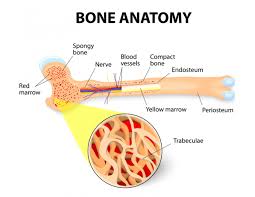
Recently Diagnosed or Relapsed? Stop Looking For a Miracle Cure, and Use Evidence-Based Therapies To Enhance Your Treatment and Prolong Your Remission
Multiple Myeloma an incurable disease, but I have spent the last 25 years in remission using a blend of conventional oncology and evidence-based nutrition, supplementation, and lifestyle therapies from peer-reviewed studies that your oncologist probably hasn't told you about.
Click the orange button to the right to learn more about what you can start doing today.
- You are here:
- Home »
- Blog »
- Multiple Myeloma »
- Healing Bone Loss – Multiple Myeloma
Healing Bone Loss – Multiple Myeloma

Survivors of breast cancer, prostate cancer, and childhood leukemia are at particularly high risk for changes in bone mineral density (BMD) / osteoporosis that can lead to fractures.[1]
The quotation excerpted above neglected to mention multiple myeloma survivors also being at particularly high risk for loss of bone mineral density. While bisphosphonates represent an FDA approved bone strengthening therapy, MM survivors can also take advantage evidence-based non-toxic bone health therapies as well.
According to research, 90% of multiple myeloma survivors will experience either bone lesions or pathologic bone damage at some time during their lifetimes. While multiple myeloma itself can cause much of that bone damage, research indicates that MM chemotherapy regimens also cause bone damage.
Please don’t think that your bisphosphonate therapy (zometa, aredia, pamidronate, others) is enough to manage your bone mineral density aka bone health for the rest of your life.
Like reducing your risk of a MM relapse, building your bone health requires steady, daily effort. In other words, you don’t finish with bone health therapy. Nutrition, supplementation and lifestyle work together to keep you bones healthy.
I am both a multiple myeloma survivor and MM cancer coach. I live in complete remission from my cancer by living an evidence-based non-conventional lifestyle. Non-toxic bone health therapies are central to this lifestyle.
After living with MM for more than 25 years, I would like to believe that I’m doing something right.
If you have any questions or comments please scroll down the page to post- I will reply to you ASAP.
- To learn more about managing your bone health, click now
- To Learn More about bone therapy- click now
Thank you,
David Emerson
- Multiple Myeloma Survivor
- MM Cancer Coach
- Director PeopleBeatingCancer
Recommended Reading:
- Melatonin As Anti-Aging Therapy for Age-Related Bone Loss
- Multiple Myeloma Lytic Lesions- Chemo/Radiation Weakens Bones-
- Multiple Myeloma Therapy- Healing Lytic Lesions
Addressing Bone Loss in the Cancer Survivor
“Osteoporosis, the most common late effect of cancer treatment in the US, occurs with greater frequency among cancer survivors than the general population. Survivors of breast cancer, prostate cancer, and childhood leukemia are at particularly high risk for changes in bone mineral density (BMD) / osteoporosis that can lead to fractures.[1] In breast and prostate cancer patients, bone effects are often the result of endocrine therapy–induced alterations in bone microarchitecture. They also can be caused by other types of cancer therapy, vitamin D deficiency, and other physiological changes that may or may not be related to cancer or its treatment. In childhood leukemia patients, bone effects can be caused by a variety of factors, including corticosteroid therapy, radiation therapy to the brain, and the disease itself…
Osteoporosis can exist for many years without symptoms, and the presence of a clinically symptomatic fracture may be the first indication that bone loss has occurred. Given that the majority of cancer cases occur in people over 65 years of age, and even healthy older people are at higher risk of bone changes than younger ones (eg, owing to hormonal changes, nutritional differences, lifestyle changes including reduced mobility and lack of exercise, etc), the healthcare team must be vigilant in screening, monitoring, and intervention for bone effects in the cancer survivor…
Oncology nurses are well positioned to educate cancer survivors about newer agents (eg, bisphosphonates) and lifestyle changes that can help to protect against treatment- and disease-related bone loss…
Dexamethasone treatment impairs calcium regulation and reduces bone mineralization in infant pigs.
Calcium and vitamin D metabolism, bone mineralization, and growth were studied in piglets randomly assigned to 15 d of dexamethasone (0.5 mg.kg-1.d-1, orally) or placebo. Growth velocity was significantly reduced by dexamethasone treatment (P < 0.001)…
Differences between pre- and postosteocalcin (P < 0.01) and pyridinoline (P < 0.01) were higher and wholebody, lumbar, and femur bone mineral density were lower (P < 0.05) in dexamethasone-treated piglets.
Dexamethasone-induced reductions in bone mineral mass likely result from reduced vitamin D status, reduced intestinal calcium absorption, elevated urinary calcium loss and direct effects of the steroid on bone.
When dexamethasone is used in premature infants to improve lung function, negative effects on growth and bone metabolism could occur.”
Bone loss and fracture risk associated with cancer therapy.
“Cancer patients experience osteoporosis resulting from accelerated loss of bone mineral density (BMD) caused by their treatment. Such bone loss greatly increases the risk for fracture and can have other serious effects on quality of life…


